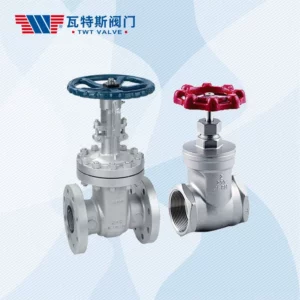Pressure reducing DIN3202F4 gate valves are used in pneumatic circuits to maintain a constant downstream pressure by automatically adjusting the flow of compressed air entering the system.
Here’s how they work:
- Valve Design: DIN3202F4 gate valves are designed with a gate mechanism that can be adjusted to control the flow of air passing through the valve. The gate can be raised or lowered within the valve body to regulate the size of the flow opening, thereby adjusting the rate at which air passes through the valve.
- Pressure Reducing Mechanism: The valve is equipped with a pressure reducing mechanism, typically a diaphragm or piston actuator, which senses the downstream pressure and modulates the position of the gate accordingly. As the downstream pressure fluctuates, the actuator responds by adjusting the gate position to maintain the desired setpoint pressure.
- Setpoint Adjustment: The desired downstream pressure is set using an external adjustment mechanism, such as a set screw or knob located on the actuator. This allows operators to adjust the pressure reducing valve to maintain the desired pressure level within the pneumatic circuit.
- Feedback Control: Some pressure reducing valves may incorporate feedback control mechanisms, such as pneumatic or electronic sensors, to continuously monitor the downstream pressure and provide feedback to the actuator. This enables the valve to make real-time adjustments to the gate position in response to changes in downstream pressure, ensuring accurate pressure regulation.
- Flow Regulation: By adjusting the position of the gate within the valve body, the pressure reducing valve regulates the flow of compressed air entering the pneumatic circuit. As the gate is raised or lowered, the flow area through the valve changes, DIN3202F4 gate valve allowing more or less air to pass through and thereby controlling the downstream pressure.
- Fail-Safe Operation: Pressure reducing valves may incorporate fail-safe features to ensure safe operation in the event of power loss or system failure. For example, some valves may include spring-loaded mechanisms that automatically close the valve when pressure drops below a certain threshold, preventing overpressurization of downstream equipment.
- Reliability and Accuracy: Pressure reducing valves are designed for reliable and accurate pressure control, providing consistent downstream pressure regulation over a wide range of flow rates and operating conditions. They are typically manufactured to high precision standards to ensure reliable performance and long-term durability in pneumatic applications.
Overall, pressure reducing DIN3202F4 gate valves maintain constant downstream pressure in pneumatic circuits by adjusting the flow of compressed air entering the system in response to changes in downstream pressure. Through precise control and regulation of airflow, these valves ensure consistent and reliable operation of pneumatic equipment and processes.
